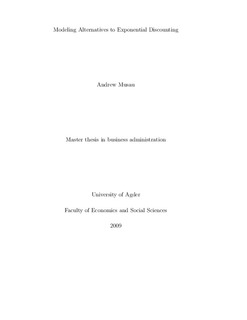| dc.contributor.author | Musau, Andrew | |
| dc.date.accessioned | 2009-11-13T11:30:23Z | |
| dc.date.issued | 2009 | |
| dc.identifier.uri | http://hdl.handle.net/11250/135604 | |
| dc.description | Masteroppgave i økonomi og administrasjon - Universitetet i Agder 2009 | en |
| dc.description.abstract | One area that is often overlooked by economists and social scientists is discounting. Most economic models of intertemporal choice make use of Samuelson’s (1937) DU model which leads to an exponential discount function. Divergences from what economic modelling predicts and empirical findings are on the most part attributed to factors other than the discount function employed. We review the literature on the DU model and identify its behavioral anomalies. We look into suggested quasi-hyperbolic and hyperbolic models that in part account for these anomalies. We analyze an infinite IPD game and demonstrate that under quasi-hyperbolic discounting, cooperation emerges as an SPE at a higher level of the discount factor. We further demonstrate that the unemployment equilibrium in the Shapiro & Stiglitz (1984) shirking model is not static under both hyperbolic and quasi-hyperbolic discounting. | en |
| dc.format.extent | 651752 bytes | |
| dc.format.mimetype | application/pdf | |
| dc.language.iso | eng | en |
| dc.publisher | Universitetet i Agder ; University of Agder | en |
| dc.subject.classification | BE501 | |
| dc.title | Modeling alternatives to exponential discounting | en |
| dc.type | Master thesis | en |
| dc.subject.nsi | VDP::Social science: 200::Economics: 210::Economics: 212 | en |
| dc.source.pagenumber | 73 s. | en |
